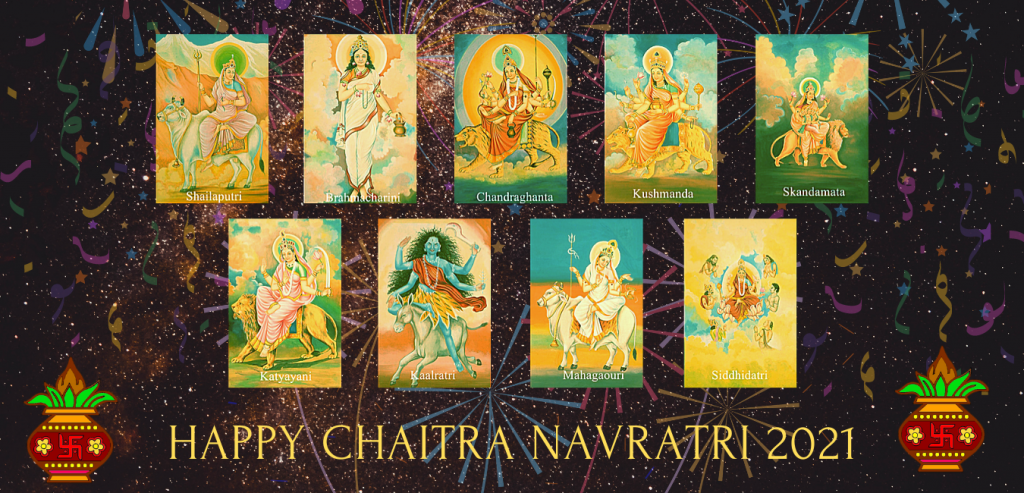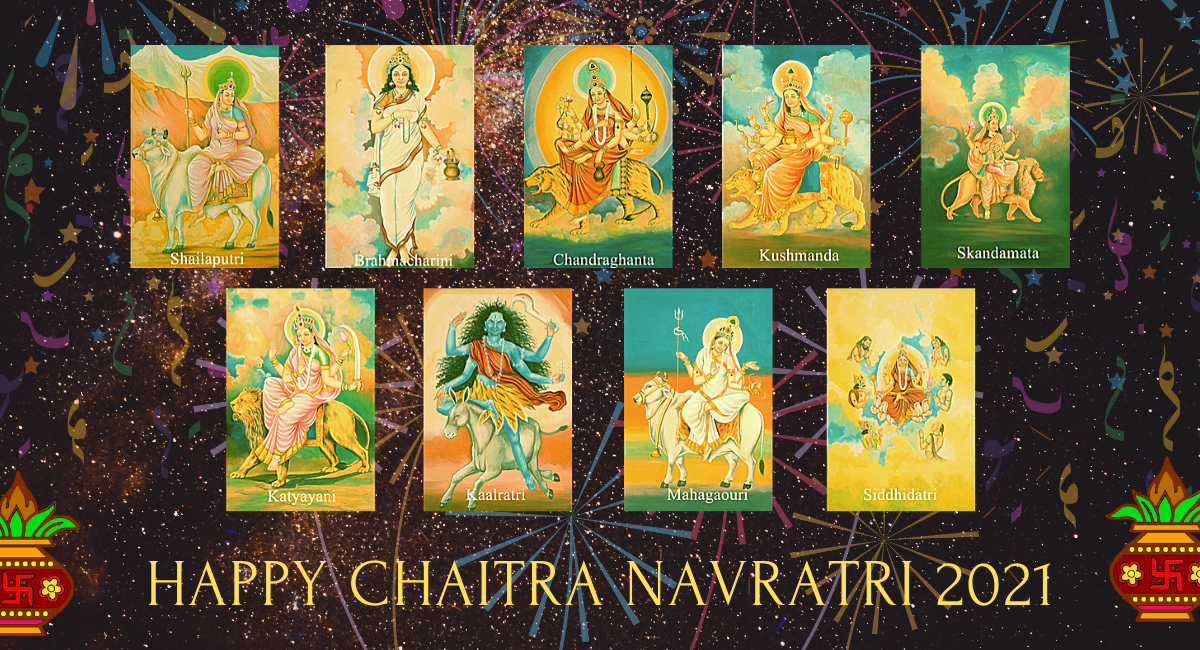
Powerful Tips to celebrate ‘Holi’ as per World of Divine Vastu
March 27, 2021
World of Divine Vastu RESOLUTIONs and TIPs to Welcome NEW YEAR 2022
December 29, 2021
Navaratri is a significant Hindu festival celebrated with much joy, enthusiasm, and fervor. It is a nine-day festival that signifies the victory of good over evil. It is believed that worshipping Goddess Durga during Navratri can help get salvation and seek her blessings for the future.
Theoretically, there are four seasonal Navaratri that fall every year. However, only two of them (Chaitra Navratri and Sharad Navratri) are considered supremely significant. The other two are ‘Gupt Navratri’.
Chaitra Navratri is the first Navratri which is also known as Vasant Navratri. As per the Gregorian calendar, it falls in March or April.
The nine nights are dedicated to the three main goddesses of Hinduism – Parvati, Lakshmi and Saraswati. Navratri is separated into sets of three days. First three days of Navratri are dedicated to Goddess Durga, the Goddess of power and energy. Next three days of Navratri are dedicated to Goddess Lakshmi, the Goddess of wealth and prosperity. The final three days belong to Goddess Saraswati who is worshipped to acquire the spiritual knowledge.
Goddess Durga is also worshipped under nine different names for the nine days in Navratri. Every day, she assumes a new character, a new look and a new duty. These nine forms of manifestation are Shailputri, Brahmacharini, Chandraghanta, Kushmanda, Skandmata, Katyayani, Kaalratri, Maha Gauri and Siddhidatri.
Chaitra Navratri 2021 Dates (USA):
This year Chaitra Navratri would start from April 12, 2021 (Monday) and would end on April 21, 2021(Wednesday). The Ashtami falls on April 20, 2021, while Ram Navami would be celebrated on April 21, 2021.
First Navratri: Goddess Shailputri
Color: Red; Bhog Offerings: Cow ghee, it is believed to bring good health and keep the diseases away.
Maa Shailputri who is worshiped on 1st day of Navaratri and the Muladhara Chakra. A color of vibrancy and life force, Red is the foundation, the grounding, the passion, and the blood. It represents survival and guides you through change. It is the harbinger of fear, danger or something unusual. In that context, it warns us to pay attention or be alert. It indicates our connection with Earth.
Second Navratri: Goddess Brahmacharini
Color: Orange; Bhog Offerings: Sugar and fruits, it is believed to give longevity to the dwellers.
Maa Brahmacharini who is worshiped on 2nd day of Navaratri and the Swadhisthana Chakra. A color of vitality and strengths, Orange is the mix of red and yellow, and is associated with calmness, stillness and wisdom. It follows the stage after our foundation is strengthened, pointing to steady growth with lighter pleasures and pains along the way.
Third Navratri: Goddess Chandraghanta
Color: Yellow; Bhog Offerings: Milk, kheer or sweets, it is believed that offering the above things to Maa Chandraghanta will give you relief from misery and pain.
Maa Chandraghanta who is worshiped on 3rd day of Navaratri and the Manipura Chakra. A color of light, energy and strength, Yellow dispels all the dark elements just like the sun dispels the dark. It is associated with your growth, maturity and optimism. It is the center of all your energies in your body.
Fourth Navratri: Goddess Kushmanda
Color: Green; Bhog Offerings: Malpua (do not add fennel seeds to it), Offering this delicacy to the Goddess is said to enhance the ability to make decisions and intellect.
Maa Kushmanda who is worshiped on 4th day of Navaratri and the Anahata Chakra. A color of love and compassion, Green is compared to grass. When you walk bare footed on the grass, the freshness of nature, the touch of Mother Earth enters your body through your feet. It pacifies your mind (mental), body (physical), heart (emotional) and soul (spiritual) altogether.
Fifth Navratri: Goddess Skandmata
Color: Blue; Bhog Offerings: Banana, it is believed that it appeases the goddess and keeps you physically fit and healthy.
Maa Skandmata who is worshiped on 5th day of Navaratri and the Vishuddha Chakra. A color of serenity, clarity, vastness and eternity, Blue is compared to the element of sky. It is associated with anything beyond your mental speculation. Blue is all-inclusive, being even one of the elements colors of fire. Lord Shiva and Lord Krishna are blue because of their being all-inclusive. In Buddhism, it is the epitome of pure, calm, tranquil and serene mind.
Sixth Navratri: Goddess Katyayani
Color – Indigo; Bhog Offerings: Honey, it is believed that offering honey appeases the goddess and she blesses you with beauty and good health.
Maa Katyayani who is worshiped on 6th day of Navaratri and the Ajna Chakra. A color of royalty, Indigo represents deeper and inner knowledge associated with your thoughts. It represents your insight and clarity of thoughts. It connects you with everything with a larger picture. It is the destructive force of all illusions harbored in your mind.
Seventh Navratri: Goddess Kaalratri
Color: Violet; Bhog Offerings: Jaggery, Offering this Bhog to the goddess is said to remove all the evils and sorrows from your life. It also safeguards you from sudden calamity.
Maa Kaalratri who is worshiped on 7th day of Navaratri and the Sahasrara Chakra. A color of Divine Light, it is associated with blissful nature of living beings. It represents the inner bliss which is above all pleasures and pains. It is the epitome of purity of mind, body and soul. It connects you with the Cosmos, which is beyond material affairs around you.
Eighth Navratri: Goddess Maha Gauri.
Color: White; Bhog Offerings: You may keep one mature Coconut at the altar of temple in your home. It is symbolic of desire fulfillment. Keep the thin edge of coconut towards the temple. You are required to immerse this coconut on the last day. Coconut, it is believed that offering this fruit appeases the goddess and she blesses you by taking away all your sorrows and by giving you success. She blesses the childless couple with child.
On the eight day, the Goddess Durga is worshipped as ‘Maha Gauri’. She is considered to extremely beautiful, white like snow and accessorized with white colored ornaments. She represents calmness and exhibits wisdom.
Ninth Navratri: Goddess Siddhidatri
Color: Pink; Bhog Offerings: Til (Sesame) or Flowers. Offering sesame or flowers makes this goddess happy and she blesses you with various Siddhis.
Maa Siddhidatri worshipped on the 9th day of Navratri. She is glorified for bestowing Siddhis (perfections) onto Yogis and Sadhaks. Worshipping Goddess Siddhidatri on the final day of Navratri marks the successful completion of Navratri Poojan.
Colors for Devotees to wear:
Many devotees of Goddess Durga take these colors seriously and wear clothes accordingly. It is believed that doing so brings prosperity, blessings and good luck. So, if you want to follow it too, let us take you through the 9 colors for each day.
DAY 1-ORANGE; The festival begins with the bright and vibrant Orange. This color signifies energy and happiness.
DAY 2 – WHITE; White is the color for Day 2, which is a symbol of peace and purity.
DAY 3 – RED; People wear red color on the third day of Navratri. It signifies beauty and fearlessness.
DAY 4 – ROYAL BLUE; The color of the fourth day of Navratri is royal blue. This color is considered good for health and wealth.
DAY 5 – YELLOW; People wear yellow on the fifth day of the festival. The color stands for happiness and brightness.
DAY 6 – GREEN; This color of the sixth day signifies new beginnings and growth.
DAY 7 – GREY; The color of the seventh day is grey, a color which stands for the strength of transforming.
DAY 8 – PURPLE; Called Ashtami, many people perform Kanjaks on this day. The color of the day, purple, signifies the power of intellect and peace.
DAY 9 – PEACOCK GREEN; This day is called Navami and is the last day of the Navratri festival. Rituals are performed on this day and Goddess Siddhidatri is worshipped. The color peacock green is believed to fulfill the desires of devotees.





